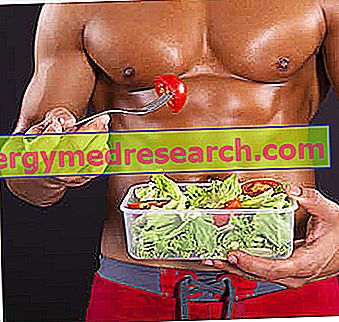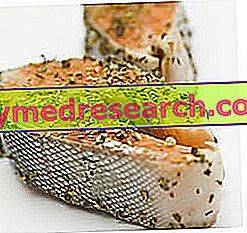Premise
The following indications are for information purposes EXCLUSIVELY and are not intended to replace the opinion of professional figures such as doctor, nutritionist or dietician, whose intervention is necessary for the prescription and composition of CUSTOMIZED food therapies.
Diet for the mass

. The principles on which a mass diet is organized can be many and the ones that PERSONALLY consider the most important will be shown below .
The diet for mass is a diet that, if associated with a specific training with overloads, can facilitate the increase of muscle mass understood as hypertrophy (and not hyperplasia).
The diet for the mass is normocaloric or high calorie (max + 10%) and follows a different nutritional distribution based on the method you intend to use; also the subdivision of the calories in the various meals is a characteristic aspect of this kind of alimentation and generally it is more fractionated compared to the classical normocaloric diet.
The diet for the mass must have some essential requirements that I will report below.
- Healthiness and nutritional balance
- Normocaloric or high calorie energy and nutritional intake
- Energy distribution divided into at least 6 meals
More in detail, the diet for the mass must bring:
- ALL the essential molecules (amino acids, fatty acids, vitamins and mineral salts) in sufficient quantities
- More protein (based on subjectivity and body composition) compared to a traditional normocaloric diet, evenly distributed throughout the day; I personally use a coefficient of 1.5-2.5 g / kg for subjects who have a fat mass (BF) lower than 10%, and a coefficient of 1.5g / kg for subjects with BF greater than 15%
- About 25-30% of fat calculated on the needs of normocalorica, even if applied in high-calorie regimes
- Carbohydrates in sufficient quantities for overall energy support and distributed in such a way as to exploit the anabolic power of insulin (stimulated by them) but without exceeding the adipose deposit.
From a practical and application point of view, food choices are the same as for a good and healthy diet.
The diet for mass is a diet that must be kept constantly under control (analysis of body composition) as an eventual energy overestimation can easily lead to excessive accumulation of fat; be clear, it is normal that favoring all anabolic processes (especially through a high-calorie) a part of the acquired mass is of adipose nature (FM), but this increase must be proportionally lower than the gain of muscle mass.
NB . The choice of a high-calorie diet includes a time limit beyond which it would be advisable not to continue; it depends above all on the response of the organism to the diet in question and on the level of fat accumulation achieved (which should never be> 15%).
Example
Engineering worker, 4 training sessions for the 90 'gym.
| Sex | Male | |||
| Age | 21 | |||
| Stature cm | 178 | |||
| Wrist circumference cm | 17 | |||
| Constitution | Normal | |||
| Stature / wrist | 10.5 | |||
| Morphological type | lanky | |||
| Weight kg | 66.2 | |||
| Body mass index | 20.9 with BF 8% | |||
| Desirable physiological body mass index | 20.9 | |||
| Desirable physiological weight kg | 66.2 | |||
| Basal kcal metabolism | 1692.2 | |||
| Coefficient of physical activity level | Moderate Yes Aus. 1.78 | |||
| Kcal energy expenditure | 3012 | |||
| Diet | IPER CALORICA | 3313, 2Kcal | ||
| Lipids | 30% of normocalorica | 903, 6Kcal | 100, 4g | |
| Protein | 2.5 g / kg | 662Kcal | 165, 5g | |
| Carbohydrates | 52.7% | 1747, 6kcal | 466g | |
| Alcohol | 0g | |||
| Breakfast | 15% | 498kcal | ||
| Snack | 10% | 330kcal | ||
| Lunch | 25% | 828kcal | ||
| Snack | 15% | 498kcal | ||
| Dinner | 25% | 828kcal | ||
| Snack | 10% | 330kcal | ||
NB : Some weights can be evaluated without the aid of a scale, for example:
- Liquid 250-300ml / g = 1 cup
- Liquid 20g = 2 tablespoons
- Grain 10g = 1 tbsp
- Fruit or vegetable 200g = medium size
- Fruit or vegetable 300g = large size
- Walnut kernel, almond, pecan nut, hazelnut = 3g
- Bread 30-35g = large slice
Example diet to increase muscle mass - DAY 1
| Breakfast, about 15% kcal TOT | |||
| Partially skimmed cow's milk | 300ml, 150 kcal | ||
| Oats | 30g, 116, 7kcal | ||
| Biscuit slices | 45g, 191.7kcal | ||
| Jam, general | 25g, 69.5 kcal | ||
| Snack, about 10% kcal TOT | |||
| Flakes of low-fat milk | 100g, 86kcal | ||
| Rye bread | 60g, 154.8kcal | ||
| Apple with peel | 200 gc, a,, 104kcal | ||
| Lunch, about 25% kcal TOT | |||
| Boiled beans | |||
| Beans, ripe seeds | 300g, 351kcal | ||
| Parmigiano | 10g, 39.2kcal | ||
| Lettuce | 100g, 18kcal | ||
| Rye bread | 90g, 232.2kcal | ||
| Extra virgin olive oil | 20g, 180kcal | ||
| Snack, about 15% kcal TOT | |||
| Natural tuna | 100g, 128kcal | ||
| Rye bread | 90g, 232.2kcal | ||
| Pere | 200g, 116kcal | ||
| Dinner, about 25% kcal TOT | |||
| Grilled swordfish | |||
| Sliced swordfish | 200g, 242kcal | ||
| Fennel | 300g, 93kcal | ||
| Rye bread | 120g, 309.6kcal | ||
| Extra virgin olive oil | 20g, 180kcal | ||
| Snack, about 10% kcal TOT | |||
| European red or white grapes | 200g, 138 kcal | ||
| Dried walnuts | 30g, 183.6 kcal | ||
Example diet to increase muscle mass - DAY 2
| Breakfast, about 15% kcal TOT | |||
| Partially skimmed cow's milk | 300ml, 150kcal | ||
| Oats | 30g, 116, 7kcal | ||
| Rusks | 45g, 191.7kcal | ||
| Jam, general | 25g, 69.5 kcal | ||
| Snack, about 10% kcal TOT | |||
| Flakes of low-fat milk | 100g, 86kcal | ||
| Rye bread | 60g, 154.8kcal | ||
| oranges | 200g, 126kcal | ||
| Lunch, about 25% kcal TOT | |||
| Lentils read | |||
| Lentils, dried | 100g, 353kcal | ||
| Parmigiano | 10g, 39.2kcal | ||
| Red radish | 100g, 23kcal | ||
| Rye bread | 90g 232.2kcal | ||
| Extra virgin olive oil | 20g, 180kcal | ||
| Snack, about 15% kcal TOT | |||
| natural tuna | 100g, 128kcal | ||
| Rye bread | 90g, 232.2kcal | ||
| Kiwi | 200g, 122kcal | ||
| Dinner, about 25% kcal TOT | |||
| Baked blue fish | |||
| Blue fish, medium | 200g, 248kcal | ||
| Zucchini | 300g, 48kcal | ||
| Rye bread | 120g, 309.6kcal | ||
| Extra virgin olive oil | 20g, 180kcal | ||
| Snack, about 10% kcal TOT | |||
| Loti or kaki | 200g, 140 kcal | ||
| Blanched almonds | 30g, 183.6 kcal | ||
Example diet to increase muscle mass - DAY 3
| Breakfast, about 15% kcal TOT | |||
| Partially skimmed cow's milk | 300ml, 150kcal | ||
| Oats | 30g, 116, 7kcal | ||
| Rusks | 45g, 191.7kcal | ||
| Jam, general | 25g, 69.5 kcal | ||
| Snack, about 10% kcal TOT | |||
| Flakes of low-fat milk | 100g, 86kcal | ||
| Rye bread | 60g, 154.8kcal | ||
| Apple with peel | 200g c, a,, 104kcal | ||
| Lunch, about 25% kcal TOT | |||
| Chickpeas boiled | |||
| Dried chickpeas | 100g, 334kcal | ||
| Parmigiano | 10g, 39.2kcal | ||
| Rocket salad | 100g, 25kcal | ||
| Rye bread | 90g, 232.2kcal | ||
| Extra virgin olive oil | 20g, 180kcal | ||
| Snack, about 15% kcal TOT | |||
| Natural tuna | 100g, 128kcal | ||
| Rye bread | 90g, 232.2kcal | ||
| Pere | 200g, 116kcal | ||
| Dinner, about 25% kcal TOT | |||
| Pan-fried veal | |||
| Calf, sirloin | 200g, 220kcal | ||
| Eggplant | 300g, 72kcal | ||
| Rye bread | 120g, 309.6kcal | ||
| Extra virgin olive oil | 20g, 180kcal | ||
| Snack, about 10% kcal TOT | |||
| European red or white grapes | 200g, 138 kcal | ||
| Hazelnuts | 30g, 188.4 kcal | ||
Example diet to increase muscle mass - DAY 4
| Breakfast, about 15% kcal TOT | |||
| Partially skimmed cow's milk | 300ml, 150kcal | ||
| Oats | 30g, 116, 7kcal | ||
| Rusks | 45g 191.7kcal | ||
| Jam, general | 25g, 69.5 kcal | ||
| Snack, about 10% kcal TOT | |||
| Flakes of low-fat milk | 100g, 86kcal | ||
| Rye bread | 60g, 154.8kcal | ||
| oranges | 200g, 126kcal | ||
| Lunch, about 25% kcal TOT | |||
| Pasta with tomato sauce | |||
| Semolina pasta | 100g, 353kcal | ||
| Tomato sauce | 100g, 24kcal | ||
| Parmigiano | 10g, 39.2kcal | ||
| Lettuce | 100g, 18kcal | ||
| Rye bread | 90g, 232.2kcal | ||
| Extra virgin olive oil | 20g, 180kcal | ||
| Snack, about 15% kcal TOT | |||
| Natural tuna | 100g, 128kcal | ||
| Rye bread | 90g, 232.2kcal | ||
| Kiwi | 200g, 122kcal | ||
| Dinner, about 25% kcal TOT | |||
| Hard-boiled eggs | |||
| Hard-boiled eggs | 100g, 143kcal | ||
| Potatoes | 200g, 154kcal | ||
| Rye bread | 120g, 309.6kcal | ||
| Extra virgin olive oil | 20g, 180kcal | ||
| Snack, about 10% kcal TOT | |||
| Loti or kaki | 200g, 140 kcal | ||
| Dried walnuts | 30g, 183.6 kcal | ||
Example diet to increase muscle mass - DAY 5
| Breakfast, about 15% kcal TOT | |||
| Partially skimmed cow's milk | 300ml, 150kcal | ||
| Oats | 30g, 116, 7kcal | ||
| Rusks | 45g, 191.7kcal | ||
| Jam, general | 25g, 69.5 kcal | ||
| Snack, about 10% kcal TOT | |||
| Flakes of low-fat milk | 100g, 86kcal | ||
| Rye bread | 60g, 154.8kcal | ||
| apples | 200g, 104kcal | ||
| Lunch, about 25% kcal TOT | |||
| Pumpkin risotto | |||
| Brown rice | 100g, 362kcal | ||
| Pumpkin | 100g, 26kcal | ||
| Parmigiano | 10g, 39.2kcal | ||
| Red radish | 100g, 23kcal | ||
| Rye bread | 90g, 232.2kcal | ||
| Extra virgin olive oil | 20g, 180kcal | ||
| Snack, about 15% kcal TOT | |||
| Natural tuna | 100g, 128kcal | ||
| Rye bread | 90g, 232.2kcal | ||
| Pere | 200g, 116kcal | ||
| Dinner, about 25% kcal TOT | |||
| Semi-skimmed milk ricotta | |||
| Semi-skimmed milk ricotta | 125g, 172.5kcal | ||
| Zucchini | 300g, 48kcal | ||
| Rye bread | 120g, 309.6kcal | ||
| Extra virgin olive oil | 20g, 180kcal | ||
| Snack, about 10% kcal TOT | |||
| European white or red grapes | 200g, 138 kcal | ||
| Blanched almonds | 30g, 183.6 kcal | ||
Example diet to increase muscle mass - DAY 6
| Breakfast, about 15% kcal TOT | |||
| Partially skimmed cow's milk | 300ml, 150kcal | ||
| Oats | 30g, 116, 7kcal | ||
| Rusks | 45g, 191.7kcal | ||
| Jam, general | 25g, 69.5 kcal | ||
| Snack, about 10% kcal TOT | |||
| Flakes of low-fat milk | 100g, 86kcal | ||
| Rye bread | 60g, 154.8kcal | ||
| oranges | 200g, 126kcal | ||
| Lunch, about 25% kcal TOT | |||
| Legumes and cereals soup | |||
| Dry mixed legumes and cereals | 100g, 350Kcal | ||
| Parmigiano | 10g, 39.2kcal | ||
| Rocket salad | 100g, 23kcal | ||
| Rye bread | 90g, 25kcal | ||
| Extra virgin olive oil | 20g, 180kcal | ||
| Snack, about 15% kcal TOT | |||
| Natural tuna | 100g, 128kcal | ||
| Rye bread | 90g, 232.2kcal | ||
| Kiwi | 200g, 122kcal | ||
| Dinner, about 25% kcal TOT | |||
| Grilled chicken breast | |||
| Chicken breast | 200g, 200kcal | ||
| Eggplant | 300g, 72kcal | ||
| Rye bread | 120g, 309.6kcal | ||
| Extra virgin olive oil | 20g, 180kcal | ||
| Snack, about 10% kcal TOT | |||
| Loti or kaki | 200g, 140 kcal | ||
| Hazelnuts | 30g, 188.4 kcal | ||
Example diet to increase muscle mass - DAY 7
| Breakfast, about 15% kcal TOT | |||
| Partially skimmed cow's milk | 300ml, 150kcal | ||
| Oats | 30g, 116, 7kcal | ||
| Rusks | 45g, 191.7kcal | ||
| Jam, general | 25g, 69.5 kcal | ||
| Snack, about 10% kcal TOT | |||
| Flakes of low-fat milk | 100g, 86kcal | ||
| Rye bread | 60g, 154.8kcal | ||
| Apple with peel | 200 gc, a,, 104kcal | ||
| Lunch, about 25% kcal TOT | |||
| Polenta with parmesan cheese | |||
| Instant polenta flour | 50g, 177.5kcal | ||
| Parmigiano | 50g, 117.6kcal | ||
| Lettuce | 100g, 18kcal | ||
| Rye bread | 90g, 232.2kcal | ||
| Extra virgin olive oil | 20g, 180kcal | ||
| Snack, about 15% kcal TOT | |||
| Natural tuna 100g | 128kcal | ||
| Rye bread 90g | 232, 2kcal | ||
| Pears 200g | 116kcal | ||
| Dinner, about 25% kcal TOT | |||
| Grilled beef fillet | |||
| Beef fillet 200g | 296kcal | ||
| Fennel 300g | 93kcal | ||
| Rye bread 120g | 309, 6kcal | ||
| Extra virgin olive oil 20g | 180kcal | ||
| Snack, about 10% kcal TOT | |||
| European red or white grapes | 200g, 138 kcal | ||
| Dried walnuts | 30g, 183.6 kcal | ||
Useful supplements in the diet for mass
Not many useful supplements to be included in the diet to increase muscle mass; their use depends essentially on the dietary composition which, if sufficiently rich and balanced, does not require any integration.
However, among the most popular products we find:
- Powdered proteins, which complete the protein intake if insufficient in the diet
- Protein bars, which unlike the previous supplement also contain sugars and fats
- Dextrose or glucose in poor, useful to promote a good insulin response
- Creatine powder, which facilitates recovery and increased muscle reserves in predisposed subjects.



